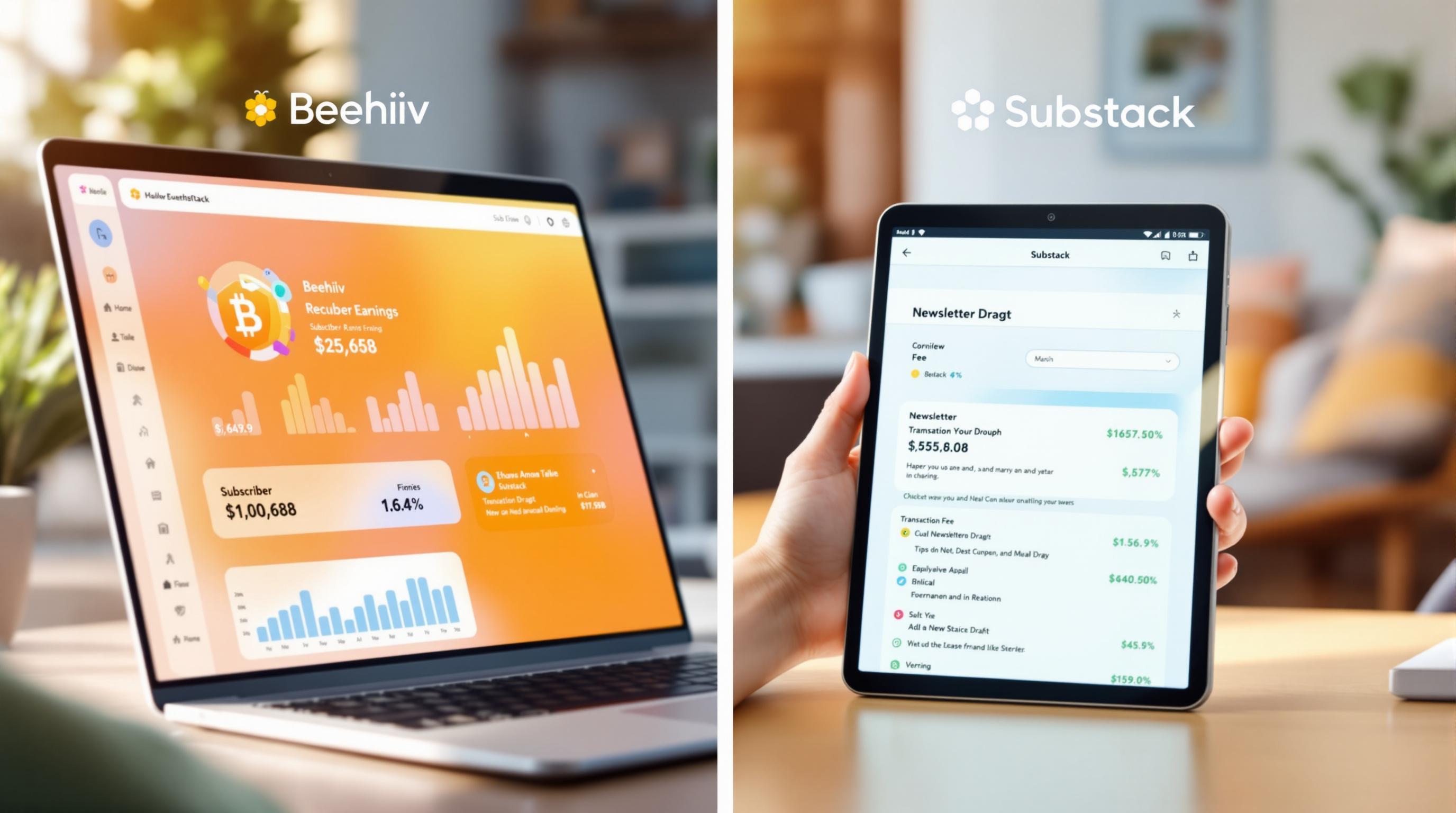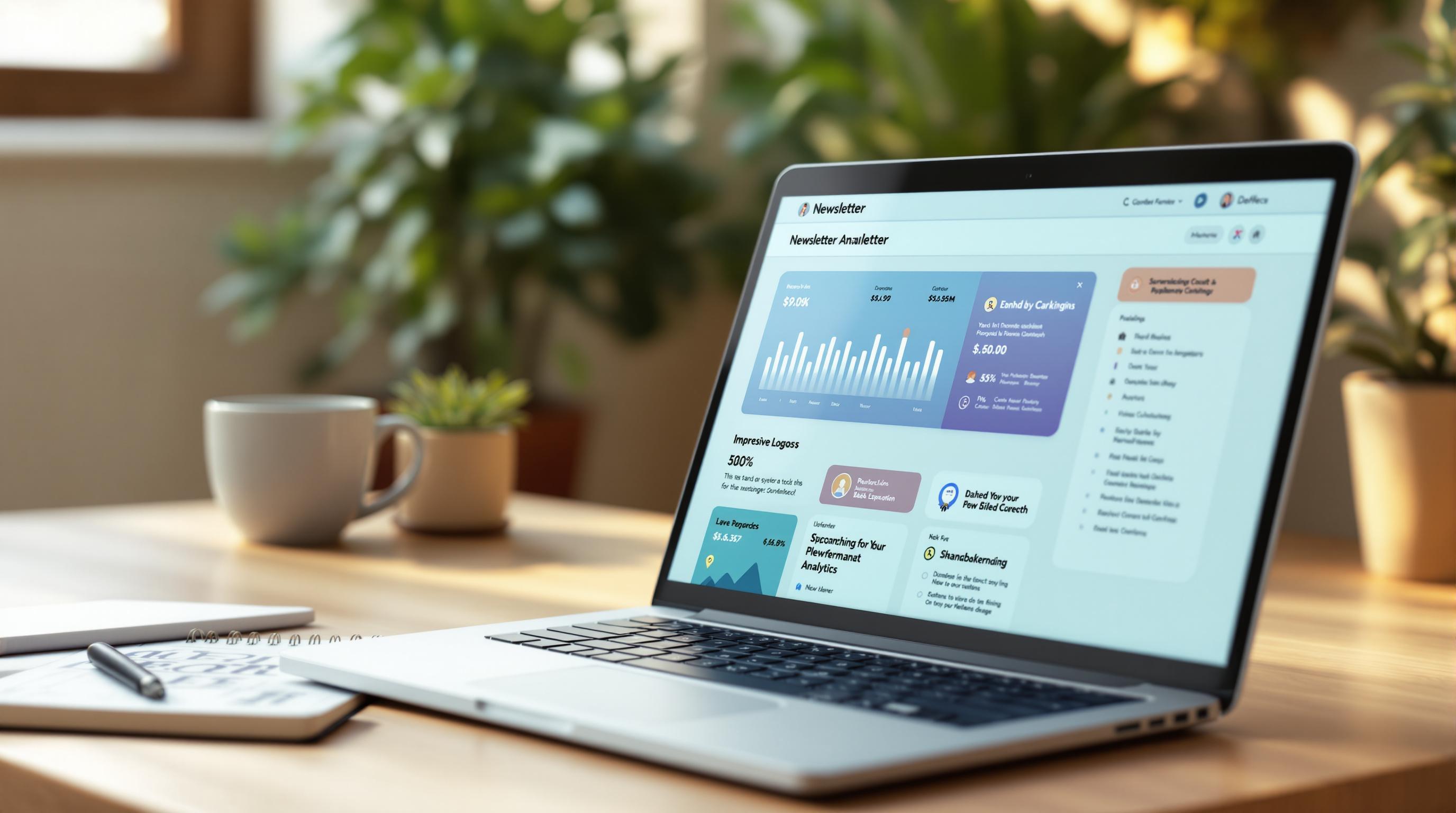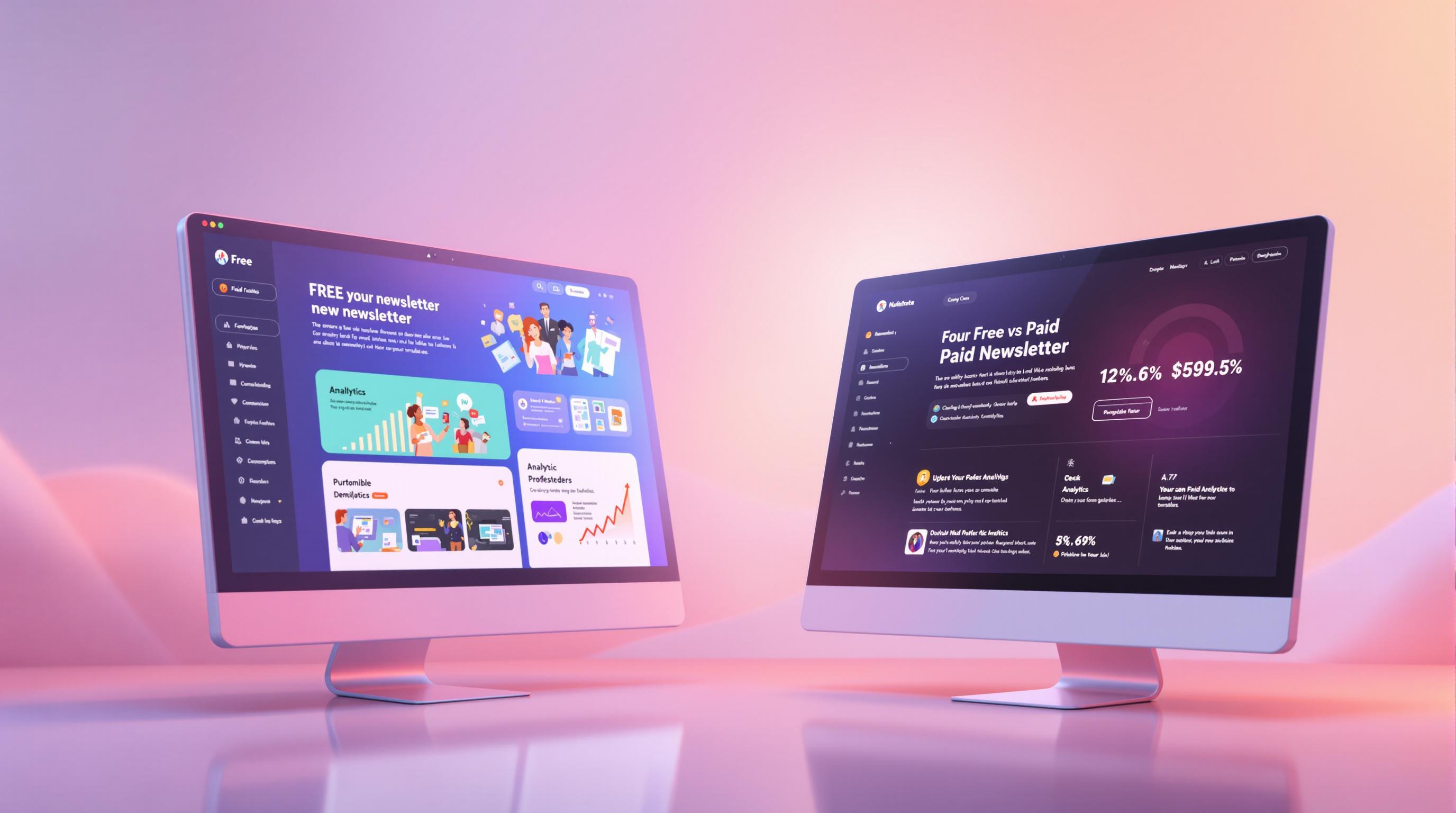Picking the right newsletter platform is crucial for your email marketing success. Here's a quick guide to help you choose:
- List your needs
- Check must-have features
- Compare different platforms
- Review technical details
- Make your final pick
Key factors to consider:
- Business goals
- Subscriber count
- Budget
- Technical skills
- Must-have features
- Growth potential
Top platforms to consider:
- Beehiiv: Great for growth-focused creators
- Substack: Ideal for solo writers
- Mailchimp: Suited for small businesses
Quick Comparison:
| Platform | Best For | Starting Price | Monetization |
|---|---|---|---|
| Beehiiv | Creators | Free up to 2,500 subs | Keep all earnings |
| Substack | Writers | Free to start | 10% fee on paid subs |
| Mailchimp | Small businesses | $13/month (500 contacts) | Not the focus |
Remember: The right platform can make or break your email marketing efforts. Choose wisely based on your specific needs and goals.
Related video from YouTube
What Is a Newsletter Platform?
A newsletter platform is a tool that helps you create and send email newsletters. It's not just a regular email tool - it's built for marketing and keeping your audience interested.
Here's what a newsletter platform lets you do:
- Grow your list of subscribers
- Make good-looking email designs
- Send emails automatically
- See how well your newsletters are doing
There are two main types of newsletter platforms: cloud-based and self-hosted.
Cloud-based platforms (like Mailchimp) are easy to use. They're great if you want to start quickly without worrying about tech stuff.
Self-hosted platforms (like MailWizz) give you more control, but you need to know your way around tech to use them.
Here's a quick look at how they're different:
| What to Consider | Cloud-based | Self-hosted |
|---|---|---|
| Easy to Use | Yes | No |
| Can Customize | Not much | A lot |
| Who Fixes Issues | The company | You |
| How You Pay | Monthly | One-time |
| Who Controls Data | The company | You |
Why use a newsletter platform? Well, for every $1 you spend on email marketing, you can make $36 back. That's a lot!
Dan Oshinsky, who knows a lot about newsletters, says: "The best email newsletters have articles that don't try to sell you stuff. They just give you info that fits your life."
Take ClassPass, for example. Their newsletter, "The warm-up", doesn't just talk about their fitness classes. It has articles about wellness, travel, and healthy eating - stuff their readers care about.
A newsletter platform isn't just for sending emails. It's for building relationships, giving value, and growing your business. Whether you pick a cloud-based or self-hosted platform, make sure it fits what you need and what you can handle tech-wise.
Remember: picking the right platform can make a big difference in how well your email marketing works. Choose carefully, and you'll be on your way to making newsletters people actually want to read.
Step 1: List What You Need
Picking the right newsletter platform boils down to knowing what you need. Let's break it down:
Business Goals
What's your newsletter's purpose? Is it to:
- Get your brand out there?
- Drive more traffic to your site?
- Show off new products?
- Keep leads warm?
Your goals will point you to the right platform. If you're all about nurturing leads, you'll want a platform with solid automation features.
Subscriber Count
How many subscribers do you expect? This number matters for two reasons:
1. Pricing: More subscribers often mean higher costs.
2. Features: Some platforms limit what you can do based on your list size.
Take Mailchimp, for example. Their free plan caps you at 1,000 subscribers and 10,000 emails per month. That might work if you're just starting, but if you're aiming for the stars, you'll need something more robust.
Budget
Money talks when it comes to choosing a platform. Here's a quick look at some popular options:
| Platform | Starting Price | Free Plan |
|---|---|---|
| Sender | $15/month | Yes (15,000 emails/month, 2,500 subscribers) |
| Mailchimp | $20/month | Yes (1,000 emails/month, 500 subscribers) |
| ActiveCampaign | $15/month | No (14-day free trial) |
| Constant Contact | $12/month | No (14-day free trial) |
| Brevo | $9/month | Yes (300 emails/day) |
Remember, these prices usually go up as your subscriber list grows. Plan for growth when you're crunching the numbers.
Technical Skills
How tech-savvy is your team? Some platforms are a breeze to use, while others might give you a headache if you're not a tech whiz.
If your team isn't big on tech, look for platforms with:
- Drag-and-drop editors
- Ready-made templates
- User-friendly interfaces
But if you've got a team of tech gurus, you might prefer a platform that lets you tinker under the hood.
Must-Have Features
What features can't you live without? Common ones include:
- Automation
- A/B testing
- Analytics
- Segmentation
- Mobile-friendly templates
Dan Oshinsky, a newsletter guru, suggests asking: "Is your newsletter flying solo or part of a bigger website?" This can help you figure out if you need a platform that plays nice with your existing systems.
Growth Potential
Think ahead. Will the platform grow with you? Consider:
- Can it handle a growing subscriber list?
- Does it work with other tools you might need down the road?
- Can you upgrade to more advanced features as you grow?
Step 2: Check Must-Have Features
Now that you've got your needs listed, let's look at the key features your newsletter platform should have:
Email Design Tools
You want a platform that makes creating great-looking emails easy. Look for:
- Drag-and-drop editors
- Customizable templates
- Mobile-friendly designs
Take Mailchimp, for example. Their email builder lets you create pro-level emails without coding. Plus, their templates work well on mobile.
Automation Capabilities
Automation is a game-changer for email marketing. It sends the right message at the right time, automatically. Key features include:
- Welcome series
- Abandoned cart reminders
- Birthday messages
- Re-engagement campaigns
ActiveCampaign is a standout here. You can create complex workflows based on how subscribers interact with your emails.
Subscriber Management
Keeping your list clean is crucial. Look for:
- Easy contact import/export
- Automatic list cleaning
- Segmentation options
GetResponse offers solid segmentation tools. You can group subscribers based on their actions, demographics, or custom fields.
Performance Tracking
To improve, you need to know how your newsletters are doing. Look for:
- Open rates
- Click-through rates
- Conversion tracking
- A/B testing
Klaviyo goes beyond basic stats. They show you how much money each email generates.
Integration with Other Tools
Your newsletter platform should play nice with your other tools. Look for integrations with:
- Your e-commerce platform
- CRM system
- Social media accounts
- Website analytics
Brevo (formerly Sendinblue) connects with lots of tools, including Shopify, WooCommerce, and Salesforce.
Pricing
Features are great, but they need to fit your budget. Here's a quick price comparison:
| Platform | Starting Price (Monthly) | Free Plan |
|---|---|---|
| Mailchimp | $20 | Yes |
| ActiveCampaign | $66 | No |
| GetResponse | $15.60 | Yes |
| Klaviyo | $20 | Yes |
| Brevo | $9 | Yes |
Keep in mind, prices often go up as your subscriber list grows. Factor in your growth plans when deciding.
sbb-itb-2653e19
Step 3: Look at Different Platforms
Now that you've outlined your needs and must-have features, let's dive into some popular newsletter platforms. We'll compare Beehiiv, Substack, and Mailchimp to see how they stack up.
Beehiiv: The new kid on the block, built for newsletter creators. It's packed with tools for growth and monetization, and doesn't take a cut of your subscriber revenue.
Substack: A hit with writers and content creators. It's known for being easy to use and having built-in ways to make money.
Mailchimp: An old hand in the game. It's got a ton of features, making it great for businesses that need more than just newsletters.
Here's how they compare:
| Feature | Beehiiv | Substack | Mailchimp |
|---|---|---|---|
| Best For | Growth-hungry creators | Solo writers | Small businesses |
| Starting Price | Free up to 2,500 subs | Free to start | $13/month (500 contacts) |
| Monetization | Keep all your earnings | 10% fee on paid subs | Not the focus |
| Ease of Use | User-friendly | Dead simple | Can be a bit much |
| Design Options | Some customization | Basic | Tons of templates |
| Analytics | Deep insights | Basic stats | Advanced number-crunching |
Each platform has its strong points. Beehiiv is making waves with its creator-first approach. Tyler Denk, Beehiiv's CEO, says:
"We're seeing creators switch to Beehiiv and grow their audience by 2-3x within the first few months."
Substack's not slouching either. They've got over 35 million active subscriptions, with 3 million paying. Writers looking to cash in on their content are flocking to it.
Mailchimp's the Swiss Army knife of the bunch. It plays nice with over 300 other platforms, making it a solid pick for businesses with a lot of moving parts.
When you're picking a platform, think about where you want to be down the road. If you're flying solo and want to turn your newsletter into a money-maker, Beehiiv or Substack might be your jam. But if you're running a small business and need a full marketing toolkit, Mailchimp could be the way to go.
Step 4: Review Technical Details
Let's dig into the tech stuff you need to know when picking a newsletter platform.
Email Deliverability
This is the big one. What's the point of writing emails if they don't show up?
Tests show the average deliverability rate is 83.1%. But check this out: ActiveCampaign hit 94.2%. That's a lot more emails landing where they should.
Here's how some platforms stack up:
| Platform | Main Inbox % | Tabs % | Spam % | Missing % |
|---|---|---|---|---|
| ActiveCampaign | 84.4 | 9.9 | 4.1 | 1.7 |
| Constant Contact | 84.2 | 7.5 | 2.5 | 5.8 |
| Benchmark | 40.9 | 6.2 | 35.7 | 17.3 |
Yikes! Benchmark saw over a third of its emails end up in spam. Not good.
Data Security and Privacy
You've got subscriber data. You need to protect it.
Harry Maugans, CEO of Privacy Bee, says:
"Email has everything to do with data privacy and is most often where businesses run afoul of digital privacy laws."
Look for:
- Tough password rules
- 24/7 security monitoring
- GDPR and CCPA compliance
And heads up: GDPR fines can hit 20 million euros or 4% of your yearly revenue. Ouch.
Data Portability
Can you take your subscriber list with you? You should be able to.
Mailchimp, for example, lets you export data once a day. That includes audiences, templates, emails, and even SMS data.
Integration Capabilities
Your newsletter tool needs to work with your other stuff.
It should connect with:
- Your online store (Shopify, WooCommerce)
- CRM systems
- Social media
- Website analytics
The more your tools talk to each other, the easier your life will be.
Mobile Compatibility
43% of people check emails on phones daily. So yeah, mobile matters.
Make sure you get:
- Mobile-friendly templates
- Easy mobile previews
- Designs that work on all screen sizes
An email that looks weird on a phone? That's asking for unsubscribes.
Step 5: Pick Your Platform
You've done your homework. Now it's time to choose. But don't rush. Here's how to pick the right newsletter platform:
Test drive during free trials. Most top platforms offer them. It's your chance to see if the platform fits.
ActiveCampaign gives you 14 days to explore. Constant Contact offers US customers a 60-day free trial. That's plenty of time to get a feel for things.
During your trial, check how easy (or hard) it is to use the platform. Can you create an email without pulling your hair out? Is the interface intuitive?
Brevo (formerly Sendinblue) is known for being user-friendly. But what's easy for one person might be tricky for another. That's why testing matters.
Good support can make or break your experience. Test it out during your trial. Send a support ticket. How long does it take to get a response? Is the answer helpful?
Think big, even if you're starting small. Can the platform grow with you? Look at subscriber limits and pricing tiers. AWeber offers a free plan to start, but you can easily upgrade as you grow.
To keep track of everything, use a checklist. Here's a simple one:
| Feature | Platform A | Platform B | Platform C |
|---|---|---|---|
| Ease of use | |||
| Customer support | |||
| Scalability | |||
| Key features | |||
| Pricing |
Fill this out for each platform you're considering. It'll help you compare apples to apples.
Matthew Guay, a respected author in email marketing, says:
"Don't be afraid to switch. After you choose an email marketing app, always remember that your decision isn't set in stone."
If you outgrow your platform or it's not meeting your needs, it's okay to make a change.
Next Steps
You've picked your newsletter platform. Great! But we're not done yet. Let's dive into what's next to make your email marketing rock.
First up: set up your account right. Define your audience and build your email list. A clean list? It's your ticket to landing in inboxes, not spam folders.
Now, heads up: your deliverability might dip at first. Don't sweat it - it's normal. The first month or so on a new platform? It's like breaking in new shoes for your sending reputation. Here's what to do:
- Start with your super fans (most engaged subscribers)
- Keep your usual sending schedule
- Watch those bounces and spam complaints like a hawk
Want a quick start? Here's your warm-up plan:
1. Connect and import
Hook up your store and bring in those contacts.
2. Clean house
Scrub that list clean.
3. First campaign
Craft and send your debut email.
4. Welcome mat
Set up a series to greet new subscribers.
5. Sign-up central
Get those forms up and running.
Let's talk money. Email marketing can be a goldmine - $1 in, $36 out on average. But to hit the jackpot, you've got to keep upping your game.
Nelly Darbois, a Physical Therapist who's cracked the email code, says:
"Every 'send' is a chance to build relationships, drop knowledge bombs, and open sales floodgates."
To make each send count, keep tabs on these numbers:
- How fast is your list growing?
- Who's jumping ship (unsubscribing)?
- Are people opening your emails?
- Are they clicking through?
- How many are crying spam?
These stats? They're your roadmap to what's hot and what's not.
Last but not least, don't shy away from the fancy features. Using Mailchimp? Check out their Customer Journey tool. It's like a GPS for your marketing - guiding contacts through personalized, automated paths.


